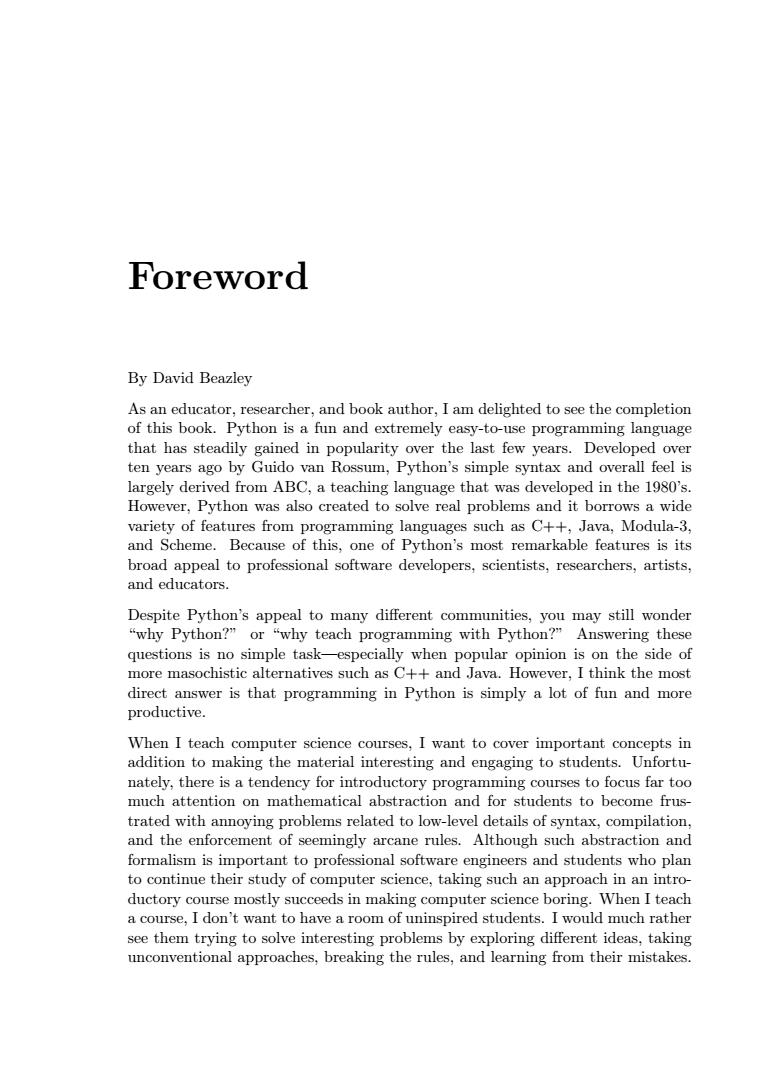正在加载图片...

Foreword By David Beazley As an educator,researcher,and book author,I am delighted to see the completion of this book.Python is a fun and extremely easy-to-use programming language that has steadily gained in popularity over the last few years.Developed over ten years ago by Guido van Rossum,Python's simple syntax and overall feel is largely derived from ABC,a teaching language that was developed in the 1980's. However,Python was also created to solve real problems and it borrows a wide variety of features from programming languages such as C++,Java,Modula-3, and Scheme.Because of this,one of Python's most remarkable features is its broad appeal to professional software developers,scientists,researchers,artists, and educators. Despite Python's appeal to many different communities,you may still wonder "why Python?"or "why teach programming with Python?"Answering these questions is no simple task-especially when popular opinion is on the side of more masochistic alternatives such as C++and Java.However,I think the most direct answer is that programming in Python is simply a lot of fun and more productive. When I teach computer science courses,I want to cover important concepts in addition to making the material interesting and engaging to students.Unfortu- nately,there is a tendency for introductory programming courses to focus far too much attention on mathematical abstraction and for students to become frus- trated with annoying problems related to low-level details of syntax,compilation, and the enforcement of seemingly arcane rules.Although such abstraction and formalism is important to professional software engineers and students who plan to continue their study of computer science,taking such an approach in an intro- ductory course mostly succeeds in making computer science boring.When I teach a course,I don't want to have a room of uninspired students.I would much rather see them trying to solve interesting problems by exploring different ideas,taking unconventional approaches,breaking the rules,and learning from their mistakes.Foreword By David Beazley As an educator, researcher, and book author, I am delighted to see the completion of this book. Python is a fun and extremely easy-to-use programming language that has steadily gained in popularity over the last few years. Developed over ten years ago by Guido van Rossum, Python’s simple syntax and overall feel is largely derived from ABC, a teaching language that was developed in the 1980’s. However, Python was also created to solve real problems and it borrows a wide variety of features from programming languages such as C++, Java, Modula-3, and Scheme. Because of this, one of Python’s most remarkable features is its broad appeal to professional software developers, scientists, researchers, artists, and educators. Despite Python’s appeal to many different communities, you may still wonder “why Python?” or “why teach programming with Python?” Answering these questions is no simple task—especially when popular opinion is on the side of more masochistic alternatives such as C++ and Java. However, I think the most direct answer is that programming in Python is simply a lot of fun and more productive. When I teach computer science courses, I want to cover important concepts in addition to making the material interesting and engaging to students. Unfortunately, there is a tendency for introductory programming courses to focus far too much attention on mathematical abstraction and for students to become frustrated with annoying problems related to low-level details of syntax, compilation, and the enforcement of seemingly arcane rules. Although such abstraction and formalism is important to professional software engineers and students who plan to continue their study of computer science, taking such an approach in an introductory course mostly succeeds in making computer science boring. When I teach a course, I don’t want to have a room of uninspired students. I would much rather see them trying to solve interesting problems by exploring different ideas, taking unconventional approaches, breaking the rules, and learning from their mistakes